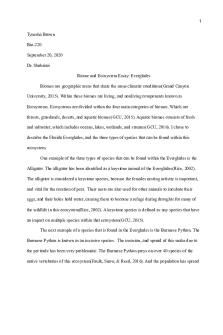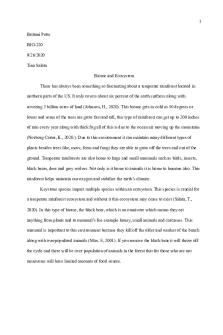Biome Chart PDF

| Title | Biome Chart |
|---|---|
| Author | Danielle Litvan |
| Course | biology |
| Institution | Immaculata University |
| Pages | 2 |
| File Size | 71 KB |
| File Type | |
| Total Downloads | 28 |
| Total Views | 159 |
Summary
Biome Chart and labels...
Description
BIOME CHART BIOME
TUNDRA
TIAGA
TEMPERATE DECIDOUS FOREST
TROPICAL RAIN FOREST
NAME ___________________________________ PD __________ CLIMATE Transitional climate between the Subarctic and ice cap climate. Characterized by very cold temperatures and generally dry conditions.
LOCATION Tundra regions are found in the northern and southern hemispheres between the ice-covered poles and the taiga or coniferous forests.
BIOTIC FACTOR - Fungi - Mosses - Shrubs - Insects - Fish - Birds - Mammals
ABIOTIC FACTOR - Temperature - Wind - Rain - Snow - Sunlight - Soil - Rocks - Permafrost
Cold, harsh climate, low rate of precipitation, and short growing season. Summers are short, and long severe winters last up to 6 months.
Northern Canada, Alaska, and Siberia The taiga is a forest of the cold, subarctic region. The subarctic is in an area of the northern hemisphere that lies just south of the arctic circle.
-
Black bear Bald eagle Red fox Wolverine Balsam fir Siberian spruce White poplar
-
Sunlight Water Boulders Soil Clouds Lightning Hail Floods Temperature
-
Plants Animals Bacteria Leaves
-
Sunlight Temperature Water Soil Clouds
-
Toucans Frogs Snakes Lizards
-
Humidity Soil composition Temperature Sunlight
Have temperatures that range from -22 to 86 degrees. Annual rainfall 30-60 in, and snow.
Temperature rarely gets higher than 93 or drops below 68 degrees. Average humidity between 77&88%; rainfall is more than 100 in a year.
Alaska, Canada, Scandinavia, and Siberia Located primarily in the eastern half of the United States, Canada, Europe, parts of Russia, Chile, and Japan
Tropical rainforests are typically found in central and south America, western and central Africa, western India, and Southeast Asia, the island of New Guinea and Australia.
-
NOTABLE INFO
BIOME CHART BIOME
DESERT
TEMPERATE GRASSLAND/SAVANNA
CHAPARRAL
NAME ___________________________________ PD __________ CLIMATE Temperatures may reach 100 degrees or more. Deserts receive less than 10 in of rain a year. Cold deserts have short, moist, and moderately warm summers. In winter, temperatures can plummet below 0 degrees, but in the summer they can reach over 90 degrees. Receive low to moderate precipitation a year (25-30 in) Very hot, and dry. Winters tend to be very mild, temperatures around 50 degrees. The winter is not very rainy, but moist. Fires and droughts are very common over the summer.
LOCATION The hot deserts of the world are located between 15 and 30 degrees north or south of the equator, where the air is subsiding or sinking. Include the plains and prairies of eastern Washington State, and other grasslands in the southwest. They can also be found between the Ukraine and Russia
In the west coast of continents. North America, South America, South Africa, and Australia. Also along the Mediterranean Sea.
BIOTIC FACTOR - Desert grass - Cacti - Yucca plant - Prickly pears - Desert cottontail - Rattle snakes - Hawk - Grass - Trees - Antelope - Prairie dogs
ABIOTIC FACTOR - Precipitation - Water availability - Sunlight - Temperature
-
Rocks Dort River Temperature
-
-
Soil Precipitation Sunlight
Plants Animals Birds Fish Mammals Insects Reptiles
NOTABLE INFO...
Similar Free PDFs

Biome Chart
- 2 Pages

Aquatic biome chart
- 5 Pages

Biome Table
- 4 Pages

Biome Assignment
- 3 Pages

Biome Diorama Project
- 1 Pages

Biome-Activity-Educator
- 5 Pages

Savanna biome - Grade: B
- 3 Pages

Biome and Ecosystem Essay
- 3 Pages

Biome and Ecosystem Essay
- 4 Pages

Biome and Ecosystem
- 5 Pages

Biome and Ecosystem Essay
- 4 Pages

Biome and Ecosystem
- 5 Pages

Biome and Ecosystem
- 4 Pages

Temperate Grasslands Biome
- 3 Pages

Biome and ecosystem Essay
- 3 Pages
Popular Institutions
- Tinajero National High School - Annex
- Politeknik Caltex Riau
- Yokohama City University
- SGT University
- University of Al-Qadisiyah
- Divine Word College of Vigan
- Techniek College Rotterdam
- Universidade de Santiago
- Universiti Teknologi MARA Cawangan Johor Kampus Pasir Gudang
- Poltekkes Kemenkes Yogyakarta
- Baguio City National High School
- Colegio san marcos
- preparatoria uno
- Centro de Bachillerato Tecnológico Industrial y de Servicios No. 107
- Dalian Maritime University
- Quang Trung Secondary School
- Colegio Tecnológico en Informática
- Corporación Regional de Educación Superior
- Grupo CEDVA
- Dar Al Uloom University
- Centro de Estudios Preuniversitarios de la Universidad Nacional de Ingeniería
- 上智大学
- Aakash International School, Nuna Majara
- San Felipe Neri Catholic School
- Kang Chiao International School - New Taipei City
- Misamis Occidental National High School
- Institución Educativa Escuela Normal Juan Ladrilleros
- Kolehiyo ng Pantukan
- Batanes State College
- Instituto Continental
- Sekolah Menengah Kejuruan Kesehatan Kaltara (Tarakan)
- Colegio de La Inmaculada Concepcion - Cebu
